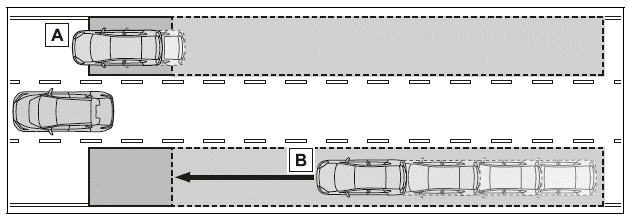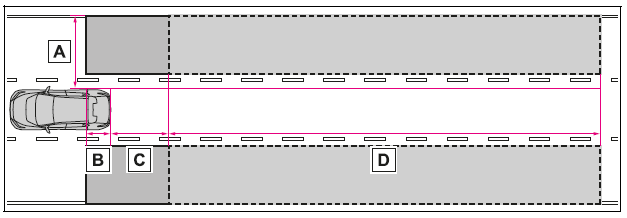Toyota bZ4X Owner's Manual: BSM (Blind Spot Monitor) – Enhanced Lateral Safety Detection
Blind Spot Monitor Operation
The Blind Spot Monitor (BSM) system utilizes rear side radar sensors mounted on the inner sides of the left and right rear bumpers to identify vehicles in areas that are typically hidden from the view of the outside rearview mirrors. When a vehicle is detected in these blind spots, the system alerts the driver using indicator lights on the mirrors.
Objects That Can Be Detected While Driving
The BSM system is designed to detect:
-
Vehicles traveling in areas outside the field of view of the outside rearview mirrors-commonly known as blind spots.
-
Vehicles that are rapidly approaching from behind in these blind zones.

Detection Range While Driving
The system defines specific areas where vehicles can be detected. These detection ranges are illustrated below:

The detection zones are as follows:
-
Approximately 1.6 ft (0.5 m) to 11.5 ft (3.5 m) from either side of the vehicle.
*Note: The zone within 1.6 ft (0.5 m) from the vehicle’s side is not monitored.
-
Approximately 3.3 ft (1 m) forward of the rear bumper.
*Note: When being overtaken, detection can extend up to about 9.8 ft (3 m) in front of the bumper.
-
Approximately 9.8 ft (3 m) from the rear bumper.
-
Approximately 9.8 ft (3 m) to 230 ft (70 m) from the rear bumper.
*Note: A larger speed differential between vehicles increases the detection distance, causing the mirror indicator to illuminate or flash.
Linked Functions
The Blind Spot Monitor is integrated with other driver assistance features, such as the Lane Departure Alert (LDA). This linked functionality uses information from adjacent-lane vehicle detection to further enhance safety during lane changes.
Operational Conditions
The Blind Spot Monitor becomes active when all the following conditions are met:
- The power switch is turned ON.
- The BSM function is enabled.
- The transmission is in a gear other than Reverse (R).
- The vehicle is moving at approximately 7 mph (10 km/h) or above.
Vehicle Detection Scenarios
The system will alert you when:
- A vehicle traveling in an adjacent lane overtakes your vehicle.
- You overtake a vehicle in an adjacent lane slowly.
- An adjacent vehicle switches lanes, entering the monitored detection zone.
Detection Limitations: When BSM May Not Detect Vehicles
Under certain conditions, the system is not able to detect vehicles or objects reliably. These include:
- Small motorcycles, bicycles, pedestrians, etc. (Detection varies depending on environmental conditions.)
- Vehicles traveling in the opposite direction.
- Stationary objects such as guardrails, walls, signs, or parked vehicles.
- Vehicles directly following in the same lane.
- Vehicles that are two lanes away from your vehicle.
- Vehicles being rapidly overtaken by your vehicle.
*Detection capabilities depend on external factors like weather and sensor positioning.
Buzzer Functionality Conditions
In some scenarios, even if the indicator flashes, an audible buzzer may not sound. For example:
- When a second vehicle is detected while the turn signal lever remains engaged.
- When overtaking a vehicle in an adjacent lane at a considerably higher speed.
*Buzzer activation depends on specific operational thresholds and driving conditions.
Conditions Impacting System Accuracy
The Blind Spot Monitor may not function correctly under the following circumstances:
-
When the sensor is misaligned due to a strong impact or if its mounting area is disturbed.
-
When mud, snow, ice, stickers, or other debris obstruct the sensor or its surrounding area on the rear bumper.
-
Adverse weather conditions such as heavy rain, snow, or fog, especially when the road surface has standing water.
-
When multiple vehicles approach closely, reducing the system’s ability to differentiate targets.
-
When the gap between your vehicle and a following vehicle is very short.
-
If there is a significant and rapidly changing difference in speed between your vehicle and a vehicle within the detection zone.
-
When a vehicle enters the detection area at nearly the same speed as your vehicle.
-
During low-speed starts, if another vehicle remains in the detection area.
-
On roads with consecutive steep inclines or dips, or sharp bends and uneven surfaces.
-
When the vehicle is equipped with accessories (for example, a bicycle carrier) or is towing, which may obstruct the sensor’s field of view.
-
If there is a significant height difference between your vehicle and an approaching vehicle.
-
Immediately after the BSM is activated, before sensor calibration stabilizes.
-
Additionally, instances of unnecessary detection (false positives) may increase when:
- The sensor is misaligned due to an impact.
- The clearance between your vehicle and adjacent guardrails or walls is insufficient.
- Driving on narrow lanes, near lane edges, or on uneven road surfaces。
- When the tires are slipping or spinning.
- During towing or when rear-mounted accessories are installed.
The Blind Spot Monitor is a pivotal component of modern vehicle safety systems, significantly enhancing driver awareness by detecting vehicles in unseen lateral zones. Its comprehensive detection ranges and linked integration with features like Lane Departure Alert provide critical support during lane changes. However, optimal performance depends on maintaining clean sensor areas and correcting any physical misalignments. Advanced driver-assist systems like this are exemplified by cutting-edge models such as the Toyota bZ4X, which set new benchmarks in safety, efficiency, and innovation.
The Blind Spot Monitor (BSM) is an essential driver assistance system that utilizes advanced rear side radar sensors, strategically mounted on the inner sides of both left and right rear bumpers, to d ...
The Safe Exit Assist is an innovative system that uses advanced rear side radar sensors mounted on the inner side of the rear bumper to provide occupants with real-time alerts. This system helps deter ...
Other articles:
Riding with Children in Your Toyota bZ4X
Ensuring the safety of children while riding in your Toyota bZ4X requires careful attention to seating positions,
restraint systems, and vehicle features designed to prevent accidents. Following these precautions helps minimize
risks and creates a secure environment for young passengers.
...
If a Warning Light Turns On or a Warning Buzzer Sounds
Remain calm and follow these steps when any warning light illuminates or the buzzer sounds. A brief activation that quickly turns off does not always signal a system malfunction. However, if the warning recurs or persists, it is important to have your vehicle inspected by your Toyota deale ...


 BSM (Blind Spot Monitor) – Advanced Driver Assistance
BSM (Blind Spot Monitor) – Advanced Driver Assistance Safe Exit Assist – Enhanced Door Safety & Exit Awareness
Safe Exit Assist – Enhanced Door Safety & Exit Awareness